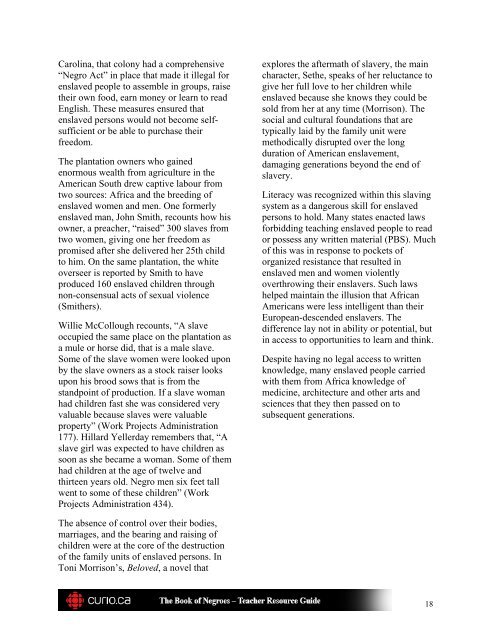ppgl2eq
ppgl2eq
ppgl2eq
You also want an ePaper? Increase the reach of your titles
YUMPU automatically turns print PDFs into web optimized ePapers that Google loves.
Carolina, that colony had a comprehensive<br />
“Negro Act” in place that made it illegal for<br />
enslaved people to assemble in groups, raise<br />
their own food, earn money or learn to read<br />
English. These measures ensured that<br />
enslaved persons would not become selfsufficient<br />
or be able to purchase their<br />
freedom.<br />
The plantation owners who gained<br />
enormous wealth from agriculture in the<br />
American South drew captive labour from<br />
two sources: Africa and the breeding of<br />
enslaved women and men. One formerly<br />
enslaved man, John Smith, recounts how his<br />
owner, a preacher, “raised” 300 slaves from<br />
two women, giving one her freedom as<br />
promised after she delivered her 25th child<br />
to him. On the same plantation, the white<br />
overseer is reported by Smith to have<br />
produced 160 enslaved children through<br />
non-consensual acts of sexual violence<br />
(Smithers).<br />
Willie McCollough recounts, “A slave<br />
occupied the same place on the plantation as<br />
a mule or horse did, that is a male slave.<br />
Some of the slave women were looked upon<br />
by the slave owners as a stock raiser looks<br />
upon his brood sows that is from the<br />
standpoint of production. If a slave woman<br />
had children fast she was considered very<br />
valuable because slaves were valuable<br />
property” (Work Projects Administration<br />
177). Hillard Yellerday remembers that, “A<br />
slave girl was expected to have children as<br />
soon as she became a woman. Some of them<br />
had children at the age of twelve and<br />
thirteen years old. Negro men six feet tall<br />
went to some of these children” (Work<br />
Projects Administration 434).<br />
explores the aftermath of slavery, the main<br />
character, Sethe, speaks of her reluctance to<br />
give her full love to her children while<br />
enslaved because she knows they could be<br />
sold from her at any time (Morrison). The<br />
social and cultural foundations that are<br />
typically laid by the family unit were<br />
methodically disrupted over the long<br />
duration of American enslavement,<br />
damaging generations beyond the end of<br />
slavery.<br />
Literacy was recognized within this slaving<br />
system as a dangerous skill for enslaved<br />
persons to hold. Many states enacted laws<br />
forbidding teaching enslaved people to read<br />
or possess any written material (PBS). Much<br />
of this was in response to pockets of<br />
organized resistance that resulted in<br />
enslaved men and women violently<br />
overthrowing their enslavers. Such laws<br />
helped maintain the illusion that African<br />
Americans were less intelligent than their<br />
European-descended enslavers. The<br />
difference lay not in ability or potential, but<br />
in access to opportunities to learn and think.<br />
Despite having no legal access to written<br />
knowledge, many enslaved people carried<br />
with them from Africa knowledge of<br />
medicine, architecture and other arts and<br />
sciences that they then passed on to<br />
subsequent generations.<br />
The absence of control over their bodies,<br />
marriages, and the bearing and raising of<br />
children were at the core of the destruction<br />
of the family units of enslaved persons. In<br />
Toni Morrison’s, Beloved, a novel that<br />
18


